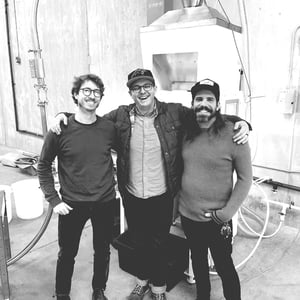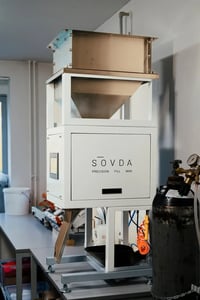What would a better sample roaster look like?
5 minute read | written by SOVDA
We all know that great roasting is the result of:
-
Being 100% present mentally.
-
Using all of our sensory abilities (looking at bean color, hearing first crack, smelling the subtle changes in aroma).
-
Analyzing the data made available by your roasting equipment.
-
Experience of how to have a clear roasting goal and get to that goal with different equipment and different green coffee.
But what if our data is incomplete or incorrect? At Sovda, we believe in leveraging technology to give roasters better data.
In this week's article, we are going to look specifically at sample roasting and what data is important.
When sample roasting, the primary goal is to achieve consistency and uniformity batch after batch. Every batch needs to be roasted to the same standard so that you can evaluate the differences in a coffee not the differences in roasting. The goal is to reduce the variable of roasting so sensory evaluation of the coffee quality can be as fair and accurate as possible.
But what defines a consistent roast?
-
Agtron? (SCA says ground Coffee Agtron is the most important standard)
-
Development time ratio? (super trendy right now, but is it being applied correctly?)
-
Development time? (time roasting after first crack)
-
Profile or ROR throughout the roast?
-
Charge temp?
-
Final bean temp (as measured on a probe)?
-
Final Infrared IR bean temp measured directly on the surface of the bean?
-
Total roast time?
-
Something else?
We can probably agree it is some combination of these. All of these will affect a roast to some degree but not equally. The question is what affects the roast the most? Or to put it another way: If you could only control 3 of these 9 factors which three would you control?
Imagine using a sample roaster with more sensors to provide your roast master with more data to achieve a more consistent and predictable batch.
At Sovda, we’ve aspired to revolutionize the sample roasting experience for specialty roasters. Our head of innovation and R&D department have been collaborating with George Fox University’s engineering team to design an innovative sample roaster from concept to final product. This new sample roaster will be named the "PROV" which means "sample" in Swedish.
We have the goal of creating a sample roaster that will give roasters the ability to control the roast of each sample based on better data from more sensors, measuring things we have never been able to measure.
The user will just need to input the moisture and density of the bean and the PROV will roast a consistent to SCI standard sample roast. The software will:
-
Identify and track when the first crack starts, middle point, and end of first crack,
-
Real-time progression and actual bean temperature through IR technology
-
and Roaster body temperature
to give the roaster accurate data values and allow for a more consistent roast.
Let's unpack this and explain how we will collect data through our sensors:
Accustic
We all know the first crack is important. But how well can you measure it just by listening? Sovda is developing an acoustic sensor that can monitor and analyze the first crack. We have found that being able to measure the start and stop of the first crack is only the beginning. But being able to analyze the cracks per second we can now access the energy-momentum going into the first crack. This is important to predict what will happen after first crack.
IR (Infrared) Temp
Through our research, we’ve found that, by design, all bean probes are unreliable. Probe type sensors measure the temperature of the probe but do not directly measure anything else. Thanks to an IR sensor, we can directly measure the bean and drum temps. Temp probs are complicated and entire books could be written so we will keep this simple. The bottom line is probs have one job: to measure temperature accurately. Probes fail at this job. The best prob in the best position is still very inaccurate.
Take a look at this example of a roast:

The IR temp is 25°c (which is the actual bean temp). The bean probe is reading 119°c (this is the bean probe temp), which is 96°c (204.8°f ) off from the actual bean temp.
At 47 seconds into the roast the IR temp and the Bean Probe temp are both 77°c. Before this point, the bean probe was reading too high starting at a 96°c delta and decreasing. And from this point on the bean probe is measuring too low, increasing to about 45°c delta and then staying between 45°c and 55°c delta for the rest of the roast. This should alarm us as roasters that our bean probes are so inaccurate both reading to low and too high at different times in the roast. Our data has shown that final bean temp measured in IR can be a very powerful critical control point.
Roaster Body Temp
Total Heat Energy (THE) and Total Heat Energy Momentum (THEM).
As roasters, we know that even with all other factors being the same as the faceplate and frame of the roaster heat up through the first several roasts you will roast inconsistently. This is usually monitored and corrected for through experience and some guesswork. The Sovda PROV will be able to monitor the heat of key components in the roasting equipment and give the roasters data to back up their intuition.
Imagine how you can roast better with better sensors providing better data.
Want to stay updated on developments with this project?
Click the link below to be the first to get sent news related to the Sovda PROV:
Latest blog posts
Visit the blog
Looking to run a more efficient roastery?
Recently, we’ve had the pleasure of working with industry leaders like Black and White Coffee, Tim Wendelboe, and Square One Coffee to ...
 Packing
Packing
Why Every Specialty Roaster Needs a Coffee Bag Filler
Manual Bagging vs. Automation As someone who started as a specialty coffee roaster myself, I know how much pride roasters take in every ...
Better coffee awaits
Chat with our team to learn more about what SOVDA can do for you. Whether you want to refine your production or grow your business, we can help. Get in touch to perfect your roastery.